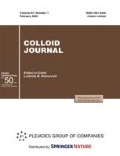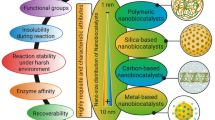Abstract—
Enzymes play significant roles in both life and industry, and increasing enzymatic activity has been a long-term goal of the biochemical science. Recently, it has been reported that nanomaterials can enhance both the specificity and yield of polymerase chain reaction (PCR) though the mechanism of this enhancement remained unclear. By using gold nanoparticles (AuNPs) as model nanomaterials and the cellulase as a typical enzyme, we studied whether and how nanomaterials affect enzymatic activities investigating various aspects of the reaction process. The results showed that the catalytic efficiency of cellulase depends on the concentration of AuNPs. By detailed studying the relation between catalysis and experimental conditions, we found that the enzymatic activity can be increased up to 13.13% upon adding AuNPs in concentration of 0.5 nM into the reaction solution. The optimal pH, temperature, and incubation time for cellulose with 0.5 nM AuNPs were found to be same as those for the cellulose alone. These findings might be useful for enhancing enzymatic activities in the industrial processes.





Similar content being viewed by others
REFERENCES
Porter, A.E., Gass, M., Muller, K., Skepper, J.N., Midgley, A.M., and Welland, M., Nat. Nanotechnol., 2007, vol. 2, p. 713.
Dorsey, J.F., Sun, L., Joh, D.Y., Witztum, A., Zaki, A.A., Kao, G.D., Basanta, M.A., Avery, S., Tsourkas, A., and Hahn, S.M., Transl. Cancer Res., 2013, vol. 2, p. 280.
Boisselier, E. and Astruc, D., Chem. Soc. Rev., 2009, vol. 38, p. 1759.
Huang, X., Jain, P.K., El-Sayed, I.H., and El-Sayed, M.A., Nanomedicine, 2007, vol. 2, p. 681.
Heddle, J.G., Catalysts, 2013, vol. 3, p. 683.
Lee, S.K., Han, M.S., Asokan, S., and Tung, C.H., Small, 2011, vol. 7, p. 364.
Garcia-Álvarez, R., Hadjidemetriou, M., Sánchez-Iglesias, A., Liz-Marzán, L.M., and Kostarelos, K., Nanoscale, 2018, vol. 8, no. 17, p. 1.
Szekeres, G.P. and Kneipp, J., Analyst, 2018, vol. 1, p. 6061.
Cserháti, T. and Szogyi, M., Peptides, 1995, vol. 16, p. 165.
Gao, L., Zhuang, J., Nie, L., Zhang, J., Zhang, Y., Gu, N., Wang, T., Feng, J., Yang, D., Perrett, S., and Yan, X., Nat. Nanotechnol., 2007, vol. 2, p. 577.
Haruta, M. and Daté, M., Appl. Catal. A-Gen., 2001, vol. 222, p. 427.
Wu, Z.C., Zhang, B., and Yan, B., Int. J. Mol. Sci., 2009, p. 4198.
Kreuzer, L.P., Mannel, M.J., Schubert, J., Höller, R.P.M., and Chanana, M., ACS Omega, 2017, vol. 2, p. 7305.
Bhat, M.K., Biotechnol. Adv., 2000, vol. 18, p. 355.
Maki, M., Leung, K.T., and Qin, W., Int. J. Biol. Sci., 2009, vol. 5, p. 500.
Funding
This work was supported by the following programs and foundations: the Program funded by the University for Fostering Distinguished Young Scholars, the Grassland Talents Program of Inner Mongolia Autonomous Region, the Distinguished Young Scholars Foundation of Inner Mongolia Autonomous Region, and the Young Leading Talents of Science and Technology Program of Inner Mongolia Autonomous Region.
Author information
Authors and Affiliations
Corresponding author
Ethics declarations
The authors have no conflict of interest.
AUTHOR CONTRIBUTIONS
Pei Gong and Min Wu contributed equally.
Rights and permissions
About this article
Cite this article
Pei Gong, Wu, M., Zhang, J. et al. Comprehensive Understanding of Gold Nanoparticles Enhancing Catalytic Efficiency. Colloid J 82, 555–559 (2020). https://doi.org/10.1134/S1061933X20050087
Received:
Revised:
Accepted:
Published:
Issue Date:
DOI: https://doi.org/10.1134/S1061933X20050087



